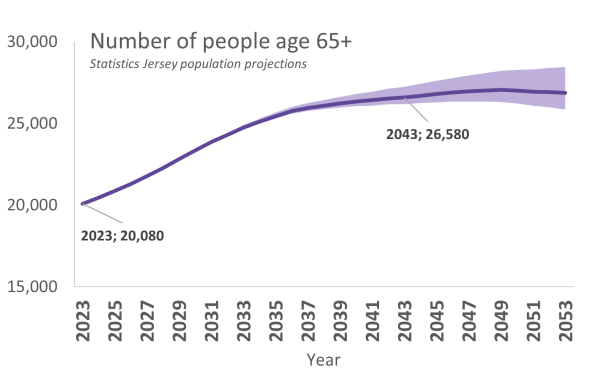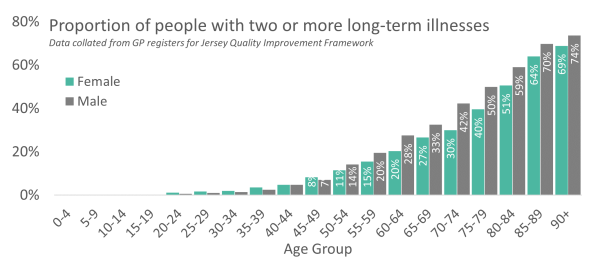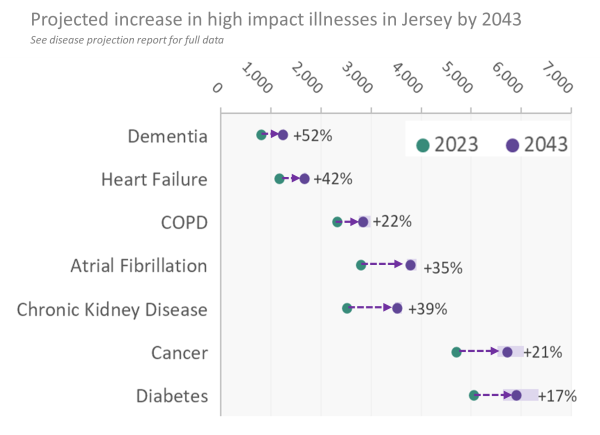How healthy will Jersey’s population be in 20 years’ time? It’s a question many people might be interested in, not least the Public Health Team. We’ve been considering the answer in our latest report on disease projections.
We don’t have a crystal ball, but we can look at levels of long-term illness in our population now, to give us an idea of what’s in store.
Jersey’s Ageing Population
Let’s start with our population: how many Islanders will there be in the future, and of what age?
To help answer this question, the folks in Statistics Jersey have recently published some population projections . Put simply, population projections are best guesses of what the future might look like based on trends and relevant data sources. We can’t be certain of the exact numbers, but one thing is for sure: people grow older every year, and people can now expect to live longer than they would have in the past.

The Statistics Team used local birth and death rates, and different assumptions about migration, to produce a range of different projection scenarios. What’s striking is that in all these scenarios, there’s a stark increase in the number of older people, regardless of whether the total population declines or grows.This is also called “an ageing population”. It’s a phenomenon occurring in countries across the world and brings lots of challenges.
Here, we’re focussing on what this means for the health of Islanders.
Long-term illness in Jersey
As a general rule, health tends to decline with age. In Jersey we see the rates of many diseases increase with age, from heart disease and lung conditions to diabetes and dementia. We tend to accumulate illnesses with age, and we see that the likelihood of living with two or more long-term illnesses (multi-morbidity) increases with age, along with the likelihood that illness will limit our day-to-day activities. Health appointments and hospital admissions also tend to become more frequent the older we get.

In the disease projection report, these patterns of disease are applied to the future population, to give projected numbers of people living with these illnesses in coming years.
It’s important to say at this point that these figures are not forecasts, rather, they demonstrate what may potentially happen if the current disease prevalence continues, while the population changes.
So, what’s the verdict?
The outlook isn’t as rosy as we might hope.
The projections suggest that an increase in the burden of ill-health could be seen pretty much across the board, including in 7 illnesses which have been designated “high impact” by The Health Foundation, in terms of their impact on health care use, and death rates.

Diseases that affect older people in particular saw big hikes in the projections; with dementia seeing a potential 52% increase by 2043 and heart failure not far behind at 42%. In terms of sheer numbers, common conditions like high blood pressure (hypertension) contribute, with over 3,000 additional people projected to be living with the condition by 2043.
These trends are not unique to Jersey. The Health Foundation in England recently published their “Health in 2040” report, which found that the number of people living with major illness is projected to increase by more than a third by 2040.
The Jersey report shows the number of people living with a long-term illness or disability that limits their daily activity is projected to increase by 12% by 2043, to almost 18,000 people. This figure is a stark reminder that some illnesses are more than an inconvenience, or just a number on the page. They can affect our quality of life, our ability to work or participate in the community, and they can be costly.
The disease projections bring into sharp focus the challenges we may have ahead, but instead of despair, we hope the insights can be galvanising. A key message to take away is that this level of illness is not inevitable in our future Jersey. Some illnesses are preventable, and there are ways people can “live well” with illness.

Chris Whitty, the UK’s Chief Medical Officer, focused his annual report on the health challenges an ageing population brings; he takes an optimistic stance, highlighting the need to focus on preventative strategies to reduce ill-health, and on enabling people to live independent and enjoyable lives into old age. Policy makers, medical professionals, and ourselves as citizens can all have a part to play.
 blog.gov.je
blog.gov.je